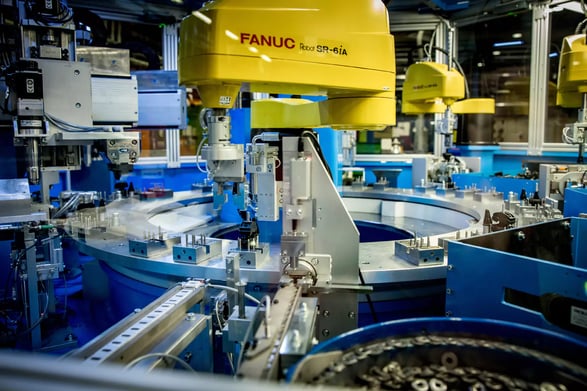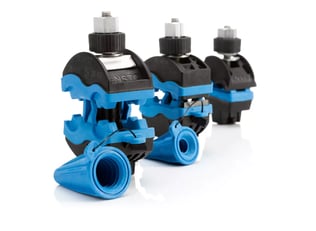.png?width=1840&name=Ensto%20(1).png)
Ensto’s journey in EPD implementation for sustainable electricity solutions
“While evaluating EPD and LCA software options, it became clear that in-house tools are preferred. Collaboration with external consultants resulted in higher costs per published EPD in addition to more resources allocated for facilitating external processes and uncertainties in timeframes.”
– Marjo Ketonen, Senior Sustainability Specialist at Ensto
EPD-driven challenges: Ensto’s path to sustainable solutions
Ensto is an international, growth-oriented family business and technology company, which creates sustainable solutions for electricity distribution. Ensto offers innovative and reliable, long-lifecycle line accessories, distribution and protection automation and control solutions as well as substations for distribution system operators and industrial customers engaged in electricity distribution. Currently, Ensto has a total of 900 employees in 17 countries in Europe, North America, and Asia. Its turnover in 2022 was €170 million.
Why are EPDs important for Ensto and its sustainability strategy?
Market demand is a major driver, and that cannot be dismissed. Also, we find it exciting that an industry focused on building electricity distribution networks is conscious and demands verified data from their suppliers in the form of EPDs or other formats such as product carbon footprints in compliance with the ISO 14067 standard. Of course, there is also regulatory pressure that comes from the construction industry since our products are part of the built environment.
Nevertheless, we also have a strong desire to have a deeper understanding of our product-specific impacts. So it’s important to have tools to not only provide this information but also enable us to be proactive about better understanding our impact – that’s why we needed a product-LCA and EPD tool that can do both.
What were the biggest challenges in assessing the environmental performance of your products — prior to using One Click LCA?
Previously, we responded to specific project- or customer-related demands using an external consultancy because we didn’t have in-house tools. A lot of resources went into finding partners, tendering discussions, agreeing on project scopes, and possible scheduling according to our needs. Product-specific sustainability claims were based only on the product performance and what it enables, not on the embedded environmental impacts since there is a risk of unintentional greenwashing if claims are not verified.
So we weren’t always able to provide an EPD even if it was requested. Instead, we produced verified carbon footprints for products, but these do not consider the whole lifecycle of a product. Usually, customers demand this kind of information immediately, so it’s crucial to have an in-house EPD tool so we can react accordingly. Sometimes, we have customized products for different regions with specific technical demands or parameters, so we need to have the capability to produce the EPD when needed.
Discovering the right EPD tool: Ensto’s selection of One Click LCA
What were the reasons you decided to go with One Click LCA for EPD production?
In Finland, where I am based – and Ensto’s headquarters is – One Click LCA is highly visible via its marketing and quite well-known here. I was also following other market leaders and LCA software providers as part of my professional interests during that time, but EPD creation seemed to be a bit of a side story with other software, which were more about the modeling and the LCA. While evaluating EPD and LCA software options, it became clear that in-house tools are preferred. Collaboration with external consultants resulted in higher costs per published EPD in addition to more resources allocated for facilitating external processes and uncertainties in timeframes. I also learned that consultants are using One Click LCA, which gave me the confidence that it’s a professional and reliable tool for various uses.
Solutions in action: Ensto’s experience with One Click LCA
What are some of the main benefits you’ve experienced using One Click LCA’s EPD Generator?
The streamlined EPD publishing support and cost-effectiveness per EPD were key benefits. I was really pleased with the level of expertise during the onboarding process. The materials offered are very valuable and I sometimes even go back to reflect on them. After the onboarding, you gain the confidence to continue using the software. My background is in a different industry, and I used to create product LCAs for much simpler materials, so it was crucial to have the support and insight from EPD and product-LCA experts. Also, it’s important that you don’t have to turn to another offer for the onboarding process to tailor it to your needs, as with the case with other software providers.
User-friendliness is also a major factor. After the inventory data collection, we don’t want to spend a lot of time modeling flows with complex interphases. The extensiveness of the database access is also important because we have complex products with a great deal of ancillary chemistry and we want to be sure we have access to credible data as suppliers are not always there to provide that information to us.
“EPDs are crucial for companies like Ensto as they provide transparent and credible information about the environmental impact of our products. Utilizing tools like One Click LCA enhances the efficiency and accuracy of creating these declarations, facilitating informed decision-making, meeting sustainability goals, and building trust with our environmentally conscious customers.”
–Markku Moilanen, President and CEO of Ensto Group

How are you currently using One Click LCA in your team?
I’m the main user, and I work alongside the product management and development team on the product structure – so how we manage the life cycle inventory data is crucial. I think many companies, like us, are now creating various EPDs while at the same time establishing processes on how to collect product-specific data, who manages it, how we communicate it, and how we use this information during development.
Do you have any favorite features?
I like the feature that allows for comparing different design scenarios. Depending on the inputs, you can see the different impacts through graphs and automated reports as you go when doing the modeling, and that’s really positive. We also appreciate the possibility of importing the BOMs (bill of materials) into Excel format. I think we will also enjoy the possibility of creating more component libraries and project files within the software. Also, advanced material manufacturing localization will be an important feature when considering options when One Click LCA is used for product development work.
Achieving sustainability milestones with EPDs: Ensto’s success story
What are some of the main insights you gathered from producing EPDs?
From the product perspective, we’ve gained a deeper understanding of the entire lifespan of products and the impacts that are formed outside Ensto gates. We also learned that if we want to develop our products in a more sustainable way, we have to collaborate and consider the kind of technologies that will be used in order to design and evaluate accordingly.
Sometimes, in the supply chain, there isn’t enough information on the impact of raw materials, so we have a strong need to develop our supply chain management in terms of how we gather information, what the information quality is, and how we communicate it. We also gained more understanding of how important it is to put pressure on our suppliers for accurate, verified representative data from impacts so that we get an idea beforehand whether a product impact can be significantly reduced from a different source, for instance. Additionally, we learned that the scenarios towards the end-of-life of a product form a great impact and we should focus on that aspect even more.
Speaking of tenders, how are you responding to the EU’s CBAM (Carbon Border Adjustment Mechanism)?
We have to consider CBAM, and we import carbon-intensive materials from outside of the EU. Nowadays, it’s important to get information from the supply chain but it’s easier to demand this kind of information, like EPDs, when you know about the process and can kind of help out your suppliers.
How has creating EPDs influenced the way that a new business/tender is won and supported your sustainability strategy?
Tenders can typically include a demand for verified data, and the EPD is part of that. External service providers for verified impacts can often be booked out and not have the capacity to create a single EPD with a tight deadline. And now we can provide an agile response. We have also had tenders where the environmental impact can be seen as an advantage and even override price factors when the competition is high, so that’s why it’s important to have EPDs ready.
Our customers ask for EPDs, or more importantly, they want reassurance that we have the capability to provide verified information in the near future. Some distribution system operators have already made national joint agreements to demand EPDs in their deliveries. Additionally, we’re planning multiple EPDs, and now we don’t have to worry about verifiers, consultancy booking, and hidden costs.
Another example is that our marketing and brand departments have been interviewing stakeholders about expectations related to the website and the desire for EPD visibility appeared even more than from our sales activities, so we are glad to be already working on those. Information derived from our first EPD, the GWP A1-3, for instance, has been added to our technical product data webpages.
“Decarbonizing MEP is a crucial part of the net-zero transition for the built environment. Ensto’s leadership in product sustainability sets the bar for MEP manufacturers who are serious about creating value with sustainability.”
–Panu Pasanen, CEO of One Click LCA
Carbon Experts Newsletter
Industry news & insights — straight to your inbox
Want to learn more?
Laura Drury • Apr 08 2024
Muhammad Ali Saleem • Jul 23 2024
Melina Zacharia • Jun 11 2024
Anna Zahrmann • Oct 02 2024

